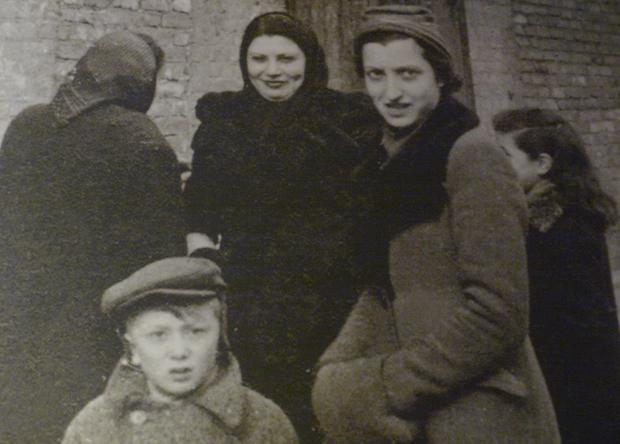Polish Archives Used in Mormon Baptism of Holocaust Victims
An archive image from Jewish Historical Institute in Warsaw, Poland. (Photo: Jamie York)
A few months ago, news surfaced that Anne Frank had been posthumously baptized by a member of the Church of Jesus Christ of Latter-day Saints.
The Mormon Church quickly apologized.
But it wasn’t the first time Anne Frank had been baptized by a Mormon, and it wasn’t the only instance of Mormon baptisms of Jewish Holocaust victims. The parents of the Nazi hunter Simon Wiesenthal were also posthumously baptized, among others.
For Mormons, posthumous baptism is a religious responsibility. A living Mormon serves as a stand-in to baptize those who weren’t Mormons in their lifetime so they can join in an afterlife. All that’s needed are names of the dead.
By the early 1960s, the Mormon Church had developed a reputation for its interest in archives with a voluminous list of names. Poland had that, but it didn’t have a lot of money to take care of its records. So in 1968 the Poles approached the Mormons for help.
“It was an agreement in which our friends from Utah were paying and providing us with equipment and materials for microfilming,” said Wladyslaw Stepniak, general director of the Polish State Archives in Warsaw.
The Mormons gave Poland cash and equipment to modernise its archives. They also paid to have locals put hundreds of thousands of primary documents onto microfilm. The Mormons got their own copy. In fact, Stepniak said the Utah microfilms are so complete that he planned to ask the Mormons to fill in gaps he’d discovered in his own archives.
“We will ask our friends in Utah – dear friends, be so kind, send us scans of these microfilms.”
Some of those microfilms include the names of Jews who died in the Holocaust, and quite a few of them have been baptized by the Mormons.
“When a person lived as a Jew and was murdered as a Jew in the Holocaust, to try and change their religion after the fact seems particularly inappropriate, distasteful, wrong,” said Michael Schudrich, the chief rabbi of Poland. He’s a New Yorker who was invited 18 years ago to help revive and lead the small Jewish community in Warsaw. He’s troubled by the Mormon baptisms.
When I asked Wladyslaw Stepniak how he responds to that concern, he was a little vague.
“What does it mean for the souls of people? Do Jews agree on this baptization after the death? No, they do not. It’s a question of religion.”
Religious people always disagree, Stepniak seemed to be saying – who is he to mediate issues of religion?
Rabbi Schudrich would be the logical one to press this case but he said he has his hands full. He’s trying to rebuild a Jewish community in Warsaw that barely survived; the baptisms are low on his list of priorities.
“We being a smaller Jewish community looked to the American Jewish community as taking care of that issue — to stop this practice of the Mormons.”
Gary Mokotoff is that American. He’s specialized in Jewish genealogy for 35 years. In 1994, he was using the Mormons’ International Genealogical Index or IGI to do research for a client. Mokotoff stumbled on a group of typically Jewish names. The IGI noted that they’d been posthumously baptized. He alerted his friends in the church, and he said they blew him off.
Before too long, though, other Jewish researchers began to notice as well.
“I started getting calls from Jewish genealogical societies in the United States saying I found relatives in the IGI,” Mokotoff said. “We traced the source, and it was a book called a Gdenkbuch, or memorial book, to 128,000 German Jews murdered in the Holocaust. What the church had done was that it had gotten a copy of the book and posthumously baptized every person who was in the book. I realized we had a crisis on our hands.”
Mokotoff and a journalist broke the story in 1995 and the Mormon Church apologized. Church leaders promised they would put a stop to the posthumous baptisms of Jews. But every few years new stories emerged.
In a written statement, the Mormon Church reiterated that it’s “absolutely firm in its commitment” to not accept names of Holocaust victims for baptism.
Mokotoff said he expects the church will ultimately honor that commitment. He calls it a “disagreement among friends” – after all, he finds the Mormon archives indispensable to his work. But, “the best way to put it is — I will not give up the souls of my ancestors for a piece of microfilm.”
At the Jewish Historical Institute of Poland in Warsaw, a film loop reminds visitors about the 3.5 million Jews who lived here before World War II.
Yale Reisner, who directs the institute’s Genealogy Project, said that there are still people, who discover, with the help of the institute, live relatives when they thought everybody was dead.
“Father and son, mother and daughter, twin brother and sister, reunions 60 years on,” Reisner said. “You can’t help but be moved by that. They’re just so happy to have someone again because they all thought they were alone in the world.”
The Mormon database helps them make those connections.
Reisner said he understands the religious reasons the Mormons gathered the names of his ancestors, and why many Jews find posthumous baptism offensive.
He, too, hopes the Mormons will learn to effectively police themselves. But he recognizes that they have created an unparalleled resource. For Reisner, working for a Jewish community here that was almost wiped out, that’s simply invaluable.
Our coverage reaches millions each week, but only a small fraction of listeners contribute to sustain our program. We still need 224 more people to donate $100 or $10/monthly to unlock our $67,000 match. Will you help us get there today?
